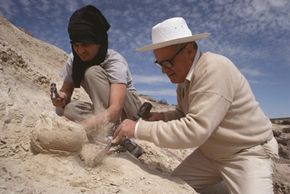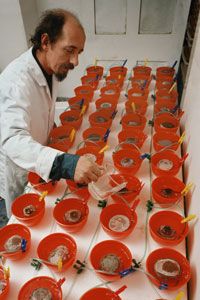In the past 20 years, paleontologists and other fossil hunters have uncovered a wealth of dinosaur eggs. Chinahas been home to many of these fossil finds, but researchers have also discovered nesting grounds in Argentina, Canada, South Africa and the United States. This is a big change -- until the 1990s, fossilized eggs were a rare find.
Dinosaur Image Gallery
Advertisement
By studying these eggs, scientists can learn about a lot more than how dinosaurs reproduced. Eggs and their positions within nesting grounds can yield lots of clues about dinosaur behavior. The structure of the eggs can help scientists figure out whether dinosaurs were more like birds or reptiles. And, in a very few cases, a fossilized egg can show paleontologists what a dinosaur embryo looked like.
The trouble is, in spite of recent finds, dinosaur eggs are still a lot rarer than dinosaur bones. On top of that, very few eggs that have survived until today still contain their embryos. This is because several specific conditions have to exist for an embryo to fossilize. First, an egg containing a healthy embryo has to be buried in sediment. A freshly laid egg, which has no visible embryo, or one that has started to rot will not do. The egg also has to be intact -- if there's a crack in the shell big enough for anything to escape, the material inside will leak out before fossilization can occur.
This buried egg then has to survive the slow process of fossilization. Groundwater containing minerals seeps through the shell, replacing the nonmineral components of the bones inside. Most of the time, soft tissues and fluids inside the egg break down or dissipate instead of becoming fossils. The shell itself is already made of calcium, so it doesn't physically change much during the fossilization process. But, if all goes well, the embryonic skeleton inside turns into rock.
The trick for researchers is to figure out how to get the rocky embryos out from the equally rocky eggs. Even though there aren't many embryo-containing dinosaur eggs out there, researchers have managed to get a look at what's inside. You'll learn how on the next page.
Advertisement

